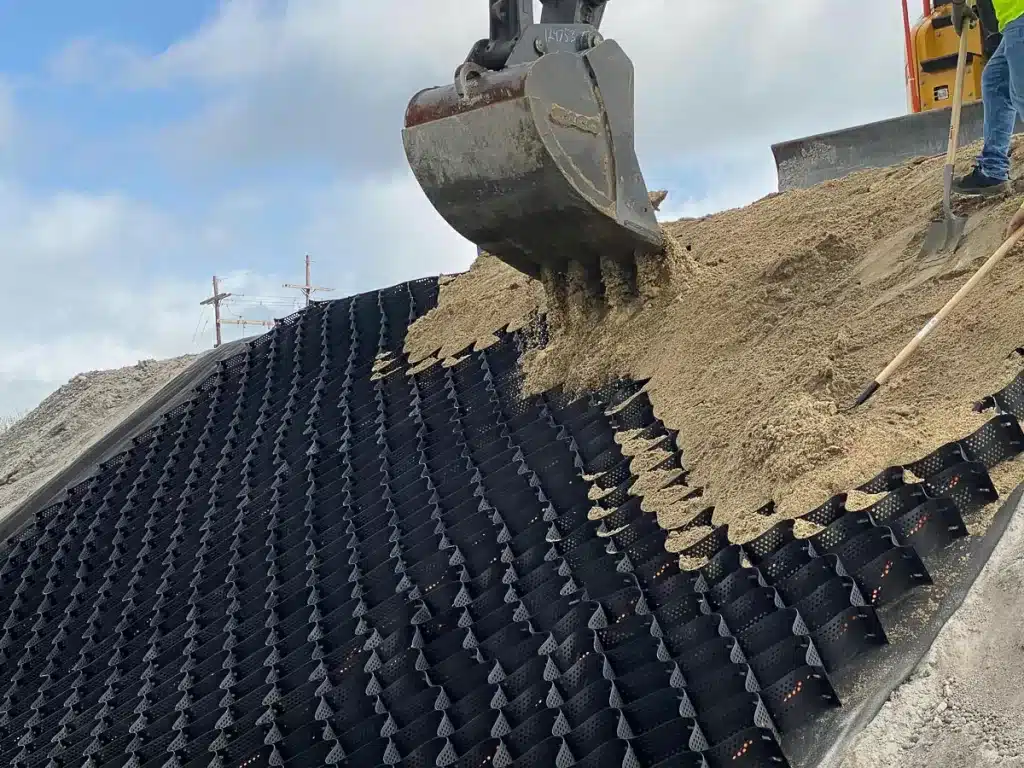+86-159 9860 6917
info@geofantex.com
geofantex@gmail.com
+86-400-8266163-44899
Among the various geosynthetic products utilized for ground reinforcement, geocells, and geogrids stand out as the most prevalent. However, understanding their disparities and optimal applications is crucial before making a selection.
Geocells and geogrids diverge in terms of their shapes, flexibility, and load-bearing capacities. While both find utility in-ground and roadway support, geocells exhibit greater suitability for soft subgrades compared to geogrids. Moreover, geogrids extend their utility beyond roads, driveways, and parking lots, finding application in the construction of retaining walls.
This article delineates the key distinctions between geocells and geogrids, elucidating their respective applications and delineating appropriate installation procedures.

Geocells vs. Geogrids
Despite their shared categorization as geosynthetic products, geocells and geogrids differ significantly based on their shape, lateral confinement, stiffness, and load-bearing capacities. Let’s delve into these distinctions.
| Shape | Geocells present as deep, three-dimensional mesh structures, resembling honeycomb formations when interlocked. Conversely, geogrids typically adopt a two-dimensional configuration, resembling tight grids. |
| Lateral Confinement and Stiffness | The two-dimensional construct of geogrids renders them more pliable than geocells, making them ideal for scenarios requiring flexible top support or separation. Geogrids feature a flatter, denser structure that constrains adjustability to a greater extent than geocells. |
| Load-Bearing Capacity | The three-dimensional structure of geocells, coupled with the vertical support offered by each cell, imparts superior load-bearing capacity. Geocells are less prone to bending, buckling, or subsiding into the subgrade over time. Furthermore, geocells accommodate a wider array of infill materials compared to geogrids, which are relatively flat and restrictive in this regard. |
| Applications | Geocells and geogrids represent two distinct types of geosynthetic products commonly employed in civil engineering projects aimed at stabilizing terrains such as slopes and erosion-prone soils. Crafted from polymers, these products find extensive usage in artificial earth-supported projects, systems, and structures requiring robust durability. |
Both geogrids and geocells excel in the construction of earth-retaining and earth-supported structures, including steep slopes and mechanically stabilized earth (MSE) retaining walls. These structures demand durability, resilience against vertical or lateral pressure, and support for other structural components.
Geocells: Ideal Applications
Geocells are optimally suited for a range of applications, including:
- Roadway projects
- Soil foundations
- Retaining walls
- Slope stabilization
- Reinforcement for structural elements
- Drainage and filtration
- Landfill and environmental barriers
Geocells facilitate the utilization of locally available, inexpensive, and even substandard aggregates. For instance, native soils, quarry waste, and recycled materials can serve as infill, reducing project costs and diverting waste from landfills.
Geogrids, on the other hand, reinforce shallow foundations by enhancing load-bearing capacity. Both uniaxial and bi-axial geogrids find utility in stabilizing soil beneath shallow foundations, offering ease of installation and distributing structural loads between the foundation and the reinforcement layer.

Roadway Projects
Geocells play a pivotal role in various roadway projects, including:
- Roads
- Pavements where reduced thickness is desired
- Access lanes
- Railroads
- Parking lots
- Runways
Geocells contribute to roadway improvement by enhancing subgrade integrity, reinforcing base and surface courses, preventing displacement of railway ballast, minimizing lateral movement of aggregate, and mitigating soil settlement.
In conclusion, while both geocells and geogrids serve as indispensable elements in ground reinforcement, understanding their unique characteristics and optimal applications is essential for effective utilization in civil engineering projects.
Get Free Sample
We’ll respond as soon as possible(within 12 hours)













